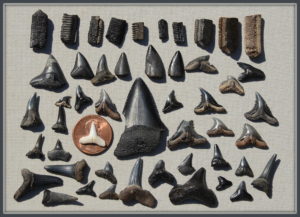Makeshift Monday
Double-click on any image to view it full size. Click the back-button to return to your place on this page.
Greetings!
Ruthi and I are back at the beach! Which is great for us, but raises an issue for producing an essay, since my pictures archives and my Lightroom software are on my desktop computer at home. This is one situation in which I can understand the attraction of having everything “in the cloud”! Sometimes in the past I have prepared an essay and saved it to my laptop before coming down. And if we come down mid-week, there is a reasonable chance of getting some nice pictures before “press time” on Sunday. However, in this case, we didn’t get down until Saturday afternoon, so photo opportunities have been very limited.
They say that necessity is the mother of invention, and just by chance today is Mother’s Day (at least in the US), so I invented a solution to the problem. Almost as soon as we got here on Saturday, I went out to the beach looking for sharks’ teeth. During a short session then, and another short session on Sunday afternoon, I found a handful of teeth, most of which are shown in the attached photo. I find it amazing that, within just a few minutes, and within a few hundred feet along the beach in front of our cottage, one can find these fossil relics of creatures that died millions of years ago. I do not even have to dig for them, or sift through tons of sand and gravel, or wade through the ocean – in fact the hardest work is simply bending down to pick them up as I walk (slowly and carefully) along the beach!

Not all the “finds” shown in the attached picture are actually shark teeth. The top row in the photo is an array of fossil dental plates from rays or skates. They are the equivalent, in those animals, of teeth, and are used for crushing and grinding prey rather than stabbing, tearing and cutting as sharks do. And the three teeth in the middle of the second row are fossil barracuda teeth.
But the “star” of the show is the white tooth just to the left of center. It is sitting on a penny to improve contrast against the otherwise rather pale background (which shows the dark teeth well), and also to give an idea of scale to the whole collection. At least here at Topsail Island, any tooth which falls to the ocean floor and is buried for any appreciable length of time is turned black by exposure to chemicals in the silt. Therefore, a tooth that gets washed up still looking white (and all shark teeth start out white) must have been lost by the shark extremely recently. According to the books that I have read, finding a white one here is very rare (even though there are still lots of sharks just off-shore). The tooth in the picture is the only white one I have found in some fourteen years of looking. And in the spirit of full disclosure I will admit that I actually found this one during our short trip down here last month. At the time I thought it was a great start to the season!
For those of you who are interested in the more technical details of the photograph, the critical parameters are 1/500 second exposure, f/16 aperture, and 400 ISO. It was taken with my trusty 28-300mm zoom lens at its maximum zoom, hand held, in rather harsh mid-afternoon sunshine. If I had had the time and equipment available, I would like to have diffused the sunlight to avoid the rather strong shadows and highlights on the teeth. Last week I illustrated how I typically use Lightroom to bring out the best in an image, but in this case what you see is only very slightly cropped, given just a hint of fill-light and sharpening using Picasa, and also given a border.
Have a great week, but do not be too surprised if there is no essay next week – it all depends what I can find during this coming week!